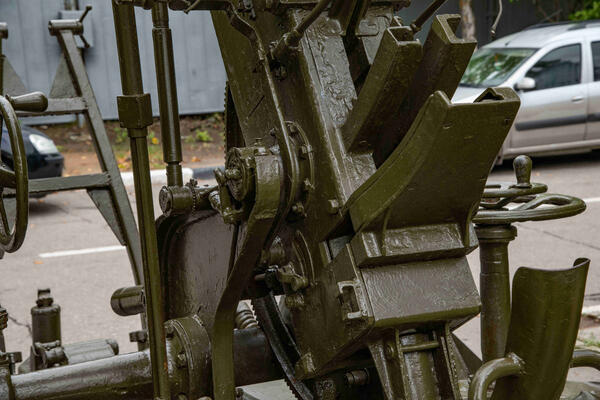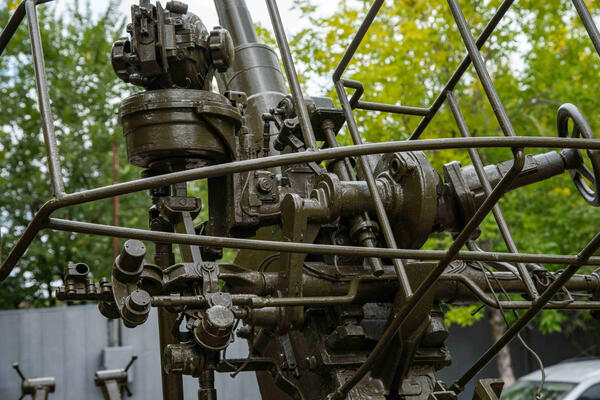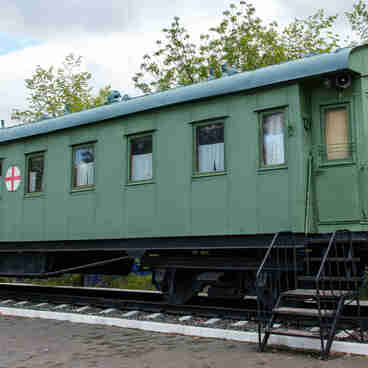The S-60 57 mm automatic anti-aircraft gun was developed at the Central Artillery Design Bureau under the leadership of Lev Abramovich Loktev. It entered service in 1950.
The autocannon was intended to fire at air targets with an effective firing range of 6 km. The S-60 used a short recoil operation system. A cooling system was installed in the gun to cool the barrel after firing a burst of 40–50 shots. It operated by pumping liquid through the bore.
Four-round clips were fed into the S-60. There was a table for the magazine with chambers and three seats for the gun crew on the upper platform of the mount. When shooting with a sight, there were five people on the platform.
In battery position, the gun weighed 4800 kg, the rate of fire was 70 rounds per minute, the initial velocity of the projectile was 1000 m/s. The weight of the projectile reached 2.8 kg. The gun was able to engage air targets moving with a speed of up to 300 m/s at a height below 4000 m.
The S-60 mainly operated by aiming with the PUAZO fire direction device. By using the PUAZO and radar, the fire could be directed at unobservable targets. The S-60 autocannon was mounted on a two-axle four-wheeled carriage, which gave it high mobility. The carriage was equipped with torsion spring suspension.
Unitary cartridges with a steel or brass sleeve were used for firing. The ammunition included blast-fragmentation and armor-piercing tracer rounds. The armor-piercing rounds made it possible to strike at ground armored targets.
Overall, during the series production about 6000 units were made. The S-60 was used in action for the first time during the Korean War (1950–1953). In the first battles, the flaws in the design of the new anti-aircraft guns were revealed, but later they were addressed.
Guns of this type were widely used in the air defense system of North Vietnam during the Vietnam War, as well as by Arab states during the Arab-Israeli conflicts and the Iran–Iraq War. At the same time, the S-60 showed high efficiency when shooting at targets at medium altitudes.
The autocannon was intended to fire at air targets with an effective firing range of 6 km. The S-60 used a short recoil operation system. A cooling system was installed in the gun to cool the barrel after firing a burst of 40–50 shots. It operated by pumping liquid through the bore.
Four-round clips were fed into the S-60. There was a table for the magazine with chambers and three seats for the gun crew on the upper platform of the mount. When shooting with a sight, there were five people on the platform.
In battery position, the gun weighed 4800 kg, the rate of fire was 70 rounds per minute, the initial velocity of the projectile was 1000 m/s. The weight of the projectile reached 2.8 kg. The gun was able to engage air targets moving with a speed of up to 300 m/s at a height below 4000 m.
The S-60 mainly operated by aiming with the PUAZO fire direction device. By using the PUAZO and radar, the fire could be directed at unobservable targets. The S-60 autocannon was mounted on a two-axle four-wheeled carriage, which gave it high mobility. The carriage was equipped with torsion spring suspension.
Unitary cartridges with a steel or brass sleeve were used for firing. The ammunition included blast-fragmentation and armor-piercing tracer rounds. The armor-piercing rounds made it possible to strike at ground armored targets.
Overall, during the series production about 6000 units were made. The S-60 was used in action for the first time during the Korean War (1950–1953). In the first battles, the flaws in the design of the new anti-aircraft guns were revealed, but later they were addressed.
Guns of this type were widely used in the air defense system of North Vietnam during the Vietnam War, as well as by Arab states during the Arab-Israeli conflicts and the Iran–Iraq War. At the same time, the S-60 showed high efficiency when shooting at targets at medium altitudes.





